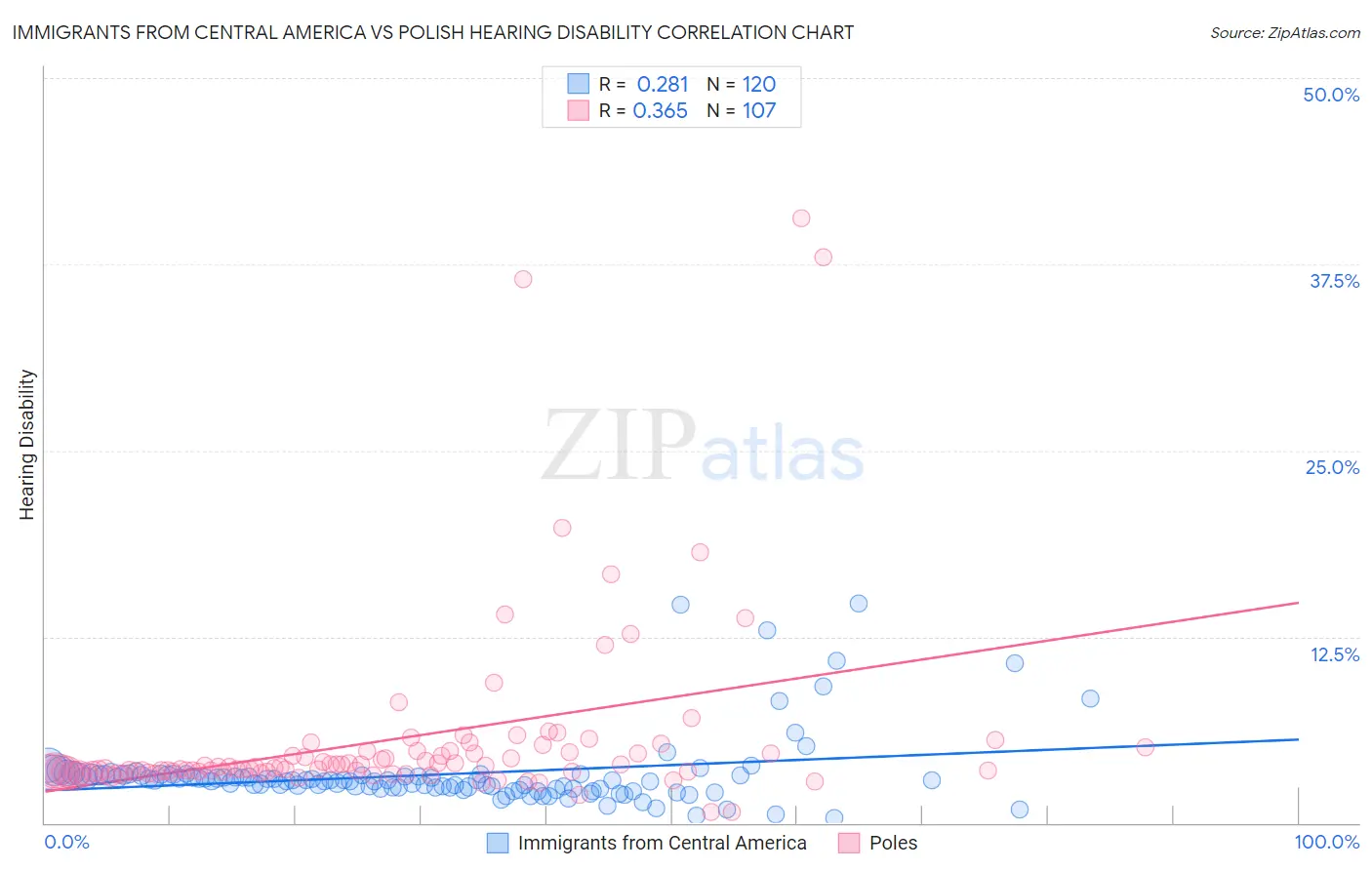Immigrants from Central America vs Polish Hearing Disability
COMPARE
Immigrants from Central America
Polish
Hearing Disability
Hearing Disability Comparison
Immigrants from Central America
Poles
3.0%
HEARING DISABILITY
64.9/ 100
METRIC RATING
163rd/ 347
METRIC RANK
3.4%
HEARING DISABILITY
0.2/ 100
METRIC RATING
255th/ 347
METRIC RANK
Immigrants from Central America vs Polish Hearing Disability Correlation Chart
The statistical analysis conducted on geographies consisting of 535,995,824 people shows a weak positive correlation between the proportion of Immigrants from Central America and percentage of population with hearing disability in the United States with a correlation coefficient (R) of 0.281 and weighted average of 3.0%. Similarly, the statistical analysis conducted on geographies consisting of 559,927,295 people shows a mild positive correlation between the proportion of Poles and percentage of population with hearing disability in the United States with a correlation coefficient (R) of 0.365 and weighted average of 3.4%, a difference of 16.2%.

Hearing Disability Correlation Summary
| Measurement | Immigrants from Central America | Polish |
| Minimum | 0.32% | 0.74% |
| Maximum | 14.7% | 40.6% |
| Range | 14.4% | 39.8% |
| Mean | 3.2% | 5.7% |
| Median | 2.8% | 3.7% |
| Interquartile 25% (IQ1) | 2.3% | 3.4% |
| Interquartile 75% (IQ3) | 3.2% | 4.8% |
| Interquartile Range (IQR) | 0.87% | 1.4% |
| Standard Deviation (Sample) | 2.4% | 6.4% |
| Standard Deviation (Population) | 2.4% | 6.4% |
Similar Demographics by Hearing Disability
Demographics Similar to Immigrants from Central America by Hearing Disability
In terms of hearing disability, the demographic groups most similar to Immigrants from Central America are Immigrants from Cambodia (3.0%, a difference of 0.020%), Immigrants from Zimbabwe (3.0%, a difference of 0.080%), Immigrants from Japan (2.9%, a difference of 0.15%), Albanian (2.9%, a difference of 0.17%), and Immigrants from South Eastern Asia (3.0%, a difference of 0.21%).
| Demographics | Rating | Rank | Hearing Disability |
| Immigrants | Poland | 70.2 /100 | #156 | Good 2.9% |
| Immigrants | Kazakhstan | 69.6 /100 | #157 | Good 2.9% |
| Immigrants | Burma/Myanmar | 69.5 /100 | #158 | Good 2.9% |
| Immigrants | Australia | 67.4 /100 | #159 | Good 2.9% |
| Immigrants | Fiji | 67.1 /100 | #160 | Good 2.9% |
| Albanians | 66.6 /100 | #161 | Good 2.9% |
| Immigrants | Japan | 66.3 /100 | #162 | Good 2.9% |
| Immigrants | Central America | 64.9 /100 | #163 | Good 3.0% |
| Immigrants | Cambodia | 64.8 /100 | #164 | Good 3.0% |
| Immigrants | Zimbabwe | 64.2 /100 | #165 | Good 3.0% |
| Immigrants | South Eastern Asia | 62.9 /100 | #166 | Good 3.0% |
| Immigrants | Eastern Europe | 58.1 /100 | #167 | Average 3.0% |
| Immigrants | Greece | 57.9 /100 | #168 | Average 3.0% |
| Arabs | 57.6 /100 | #169 | Average 3.0% |
| Immigrants | Cabo Verde | 56.9 /100 | #170 | Average 3.0% |
Demographics Similar to Poles by Hearing Disability
In terms of hearing disability, the demographic groups most similar to Poles are Hmong (3.4%, a difference of 0.040%), Slavic (3.4%, a difference of 0.23%), Yaqui (3.4%, a difference of 0.49%), Northern European (3.4%, a difference of 0.56%), and Carpatho Rusyn (3.4%, a difference of 0.65%).
| Demographics | Rating | Rank | Hearing Disability |
| Austrians | 0.6 /100 | #248 | Tragic 3.4% |
| Italians | 0.4 /100 | #249 | Tragic 3.4% |
| Yuman | 0.4 /100 | #250 | Tragic 3.4% |
| Hungarians | 0.4 /100 | #251 | Tragic 3.4% |
| Croatians | 0.4 /100 | #252 | Tragic 3.4% |
| Carpatho Rusyns | 0.3 /100 | #253 | Tragic 3.4% |
| Slavs | 0.2 /100 | #254 | Tragic 3.4% |
| Poles | 0.2 /100 | #255 | Tragic 3.4% |
| Hmong | 0.2 /100 | #256 | Tragic 3.4% |
| Yaqui | 0.2 /100 | #257 | Tragic 3.4% |
| Northern Europeans | 0.2 /100 | #258 | Tragic 3.4% |
| Slovenes | 0.1 /100 | #259 | Tragic 3.5% |
| Portuguese | 0.1 /100 | #260 | Tragic 3.5% |
| Hawaiians | 0.1 /100 | #261 | Tragic 3.5% |
| Immigrants | North America | 0.1 /100 | #262 | Tragic 3.5% |